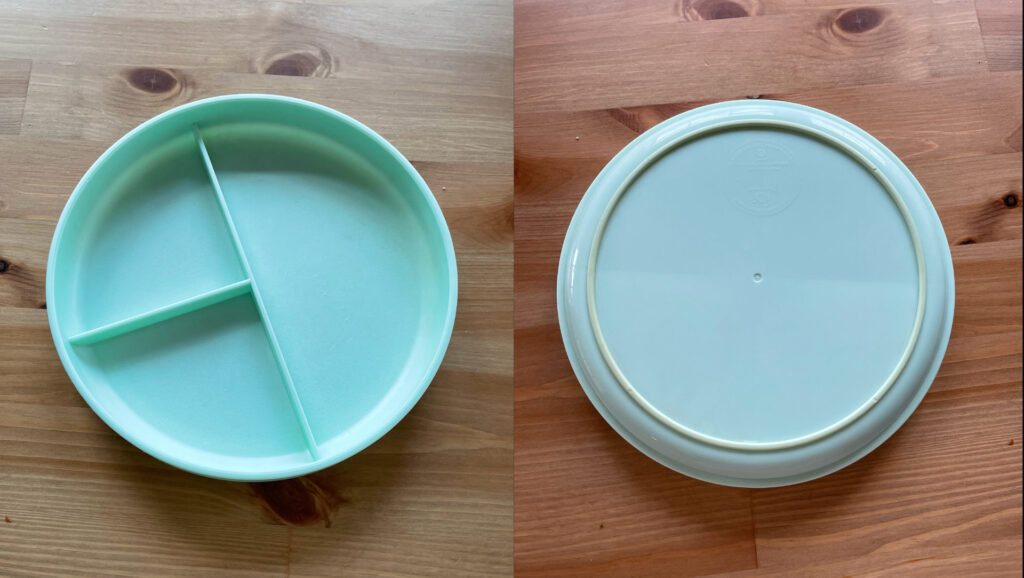This plastic plate was purchased from Target around 2021. It has handy dividers and a molded logo. We sometimes use these plates for dry snacks but avoid using plastic for hot food.
How do you think it tested via XRF?

Reading on the Base:
| Element of Interest | Parts per million (ppm) | Error Range |
|---|---|---|
| None Detected | ||
| Other Elements | ||
| Barium (Ba) | 88 | +/- 38 |
| Nickel (Ni) | 14 | +/- 4 |
| Titanium (Ti) | 3,123 | +/- 121 |
| Iron (Fe) | 30 | +/- 8 |
The sample was tested in consumer goods TestAll mode using a Niton XL3t 700S for 60 seconds. Results are rounded to the nearest whole number.
How did this item perform compared to lead limits for kid’s products?
The item is non-detect for elements of interest.
The item tested is below the federal lead restrictions for children’s products which limits products intended for use by children 12 and under to 90-100 parts per million lead. The item is a new children’s product and is subject to these regulations.
We think this is a good product for children by a reputable company. But plastic is not always our preferred serving material (see below).
We Prefer:
Although the plate tested well, we prefer stainless steel plates and glass plates for hot food. Plastic can leach chemicals into food through heat or prolonged contact. We sometimes use this plate for cold snacks like chips or crackers. We also use stainless spoons with plastic handles which makes the product easier for kids to grip.
To avoid lead in plates served to children we recommend skipping all glazed ceramic plates, and all dishes with painted details, since many vintage products are high in lead in paints and/or glazes. Although compliant dishes from 1971 and newer are leach tested, we do not think it is acceptable to use lead for this type of product. Exterior coatings may contain lead paint that wears and chips, dishes wear over time, and lead free or trace lead alternatives are cheap and available. We also recommend avoiding plates and cups made from unknown metals, mixed metals joined with solder, brass, or decorative enamel, or crystal.
When possible, we recommend that all items used by children in the kitchen be lead free, with the exception of trace lead in products that are leach tested, preferably under 90 ppm lead on surface coatings, which is considered to be within legal safety limits for children’ s products.
We recommend avoiding vintage plastic utensils and plates, which can contain high levels of lead, cadmium, or BPA.
Recommended Plates:
Disclosure: These are Amazon affiliate links. By shopping for any item on Amazon starting with our links, you help support our business and testing.
The kid’s plate tested above is available from Target’s website here.

Why we like it: We use these divided stainless plates by Wealers. They are affordable and haven’t rusted despite years of use and abuse. We do not use the storage bag.
Corelle Livingware set of 4 8-1/2-Inch Divided Dish, Winter Frost White

Why we like it: Corelle makes lead free glass plates in the USA. If you aren’t concerned about the plate shattering, this is a great option for use with kids.
Re Play Made in USA 4pk White Large Sandwich Divided Plates with Deep Sides and Three Compartments

Why we like it: These plastic divided plates are made in the USA from recycled milk jugs.
Disclaimer: These items have not always been personally tested by us but are likely to be lead free or low lead and/or cadmium based on our research into the materials, discussions with manufacturers, and/or testing on similar products. We recommend items we would use ourselves.
We provide our XRF testing for general educational or informational purposes only to help consumers identify low lead and lead-free products. We hereby disclaim any and all warranties, expressed or implied, and assume no duty or responsibility with respect to how any person or entity chooses to use the information on this website.

